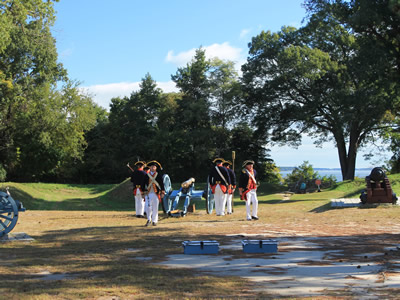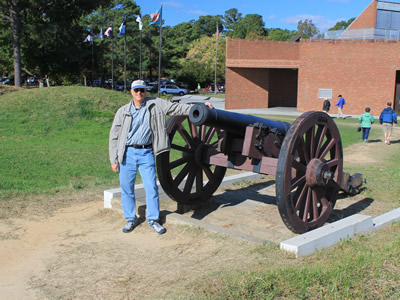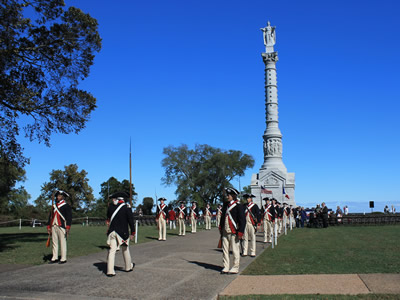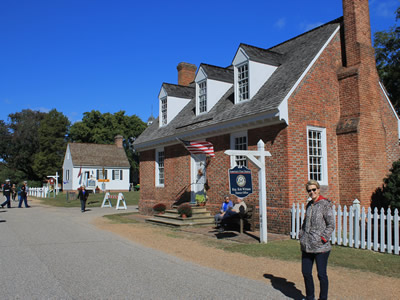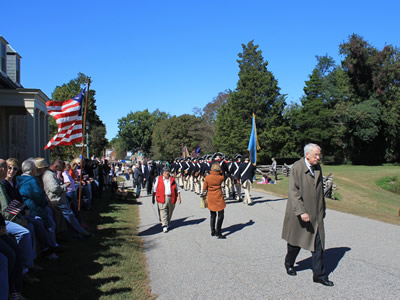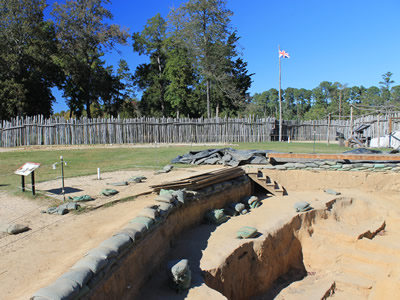Colonial National Historical Park
Since Sandy had to present her paper at the Engineering Management conference on Saturday morning, we didn't have the full day to explore. We spent our free time walking along the ocean in Virginia Beach. Sunday was our first chance to roam further afield. Sandy's dean, from the college of engineering, was also at the conference. He had grown up nearby and was familiar with the area. He recommeded that we go check out Williamsburg. That gave me a place to start my research on the web Saturday night. Colonial Williamsburg was one place that I found that we could visit. It was a historic part of the city that featured actors in costumes that recreated a town of colonial times. But then I found something that looked even better. The Yorktown Battlefield, where the final campaign of the Amercian Revolution was fought, was very close to Williamsburg. It was part of the Colonial National Historical Park, which also included Jamestown, the first English settlement in America. Since I'm a wargamer and am very interested in military history, we had to go visit Yorktown. Jamestown, a place that we all remember from our American History classes, would also be very interesting to see.
The park website listed a lot of special events, parades and reenactments for the 233rd anniversary of the surrender of the British forces at Yorktown. It looked like that would be a fun time to visit the park. Then I noticed the date - October 19. That was tomorrow! We couldn't have planned it better. It's definitely better to be lucky than good.
Since it was a special day we thought that we better get an early start to beat the crowds. The first event was at ten am so we figured that we should get there before that. We had to factor in an hour drive to reach Yorktown. An intersting feature of the drive was the Hampton Roads Bridge Tunnel from Norfolk to Hampton Roads. It is three and a half miles long and is a combination of bridges, artificial islands and tunnels. The tunnels are particularly interesting because you are driving along a causeway with water all around you when the road suddenly dives down under the water and disappears. The tunnels allow channels for the high volume of shipping that passes through the Chesapeake Bay area, especially extremely large ships like aircraft carriers. The US Second Fleet is based in Norfolk. From the bridge we could see several aircraft carriers sitting in port.
When we got to the park there were quite a few cars but we had no trouble finding a parking spot in the large lot. Our first stop was the visitor center, to check out the exhibits and watch a movie which told the story of the Yorktown campaign. Finally, before leaving the visitor center, we had to visit the gift shop. I found a Yorktown battlefield tshirt, baseball cap and an excellent book on the Yorktown campaign from Osprey Publishing, which specializes in military history books. Then it was time for the special activities to start. Right behind the visitor center, on a portion of the old British fieldworks from the battle, was a demonstration of firing one of the artillery pieces used in the siege. A ranger gave a talk (more like she bellowed than talked - there were a lot of people) as a mock gun crew dressed in Continental Army uniforms showed how the field piece was loaded and fired. After the demonstration we spent time walking around the British field works which are still preserved near the visitor center. Across a large field, 800 yards away, we could see a flag and a series of low mounds that marked the American positions.
The village of Yorktown was about a mile away and there was a nice path that led there from the visitor center. We decided to walk rather than give up our parking spot - more people were arriving all the time. This worked out well as we walked by many old buildings that were well preserved from revolutionary times. There were a lot of people too. Many of the locals were dressed in eighteenth century clothes. Most of the men wore military uniforms, but even a lot of women and kids were dressed in period clothes as well. The people of Yorktown take their history seriously.
There was a hurge pancake breakfast going on in a small park. It looked like an ordinary Sunday picnic except that since it was run by a local women's historical society, all of the servers were wearing colonial costumes. There was also going to be a parade later. There were a lot of military groups getting ready to participate. I even saw a couple of French army and one French navy officer. They were there to commemorate the cooperation between the Americans and the French Army and Navy during the Yorktown campaign that trapped the British army under Cornwallis and led to their surrender.
We walked down to the riverfront for lunch at the Riverwalk Restaurant. We had a nice lunch with a beautiful view of the York River. We were right below the Hwy 17 bridge across the river. But 230 years ago at the Battle of Yorktown, the British trapped in Yorktown were in basically the same spot looking longingly across the York River to the other side held by British forces under the infamous Colonel Banastre Tarleton. They tried and failed to get across the river to escape the American/French army that had them trapped and eventually had to surrender an entire field army.
After lunch we passed the beginning of the parade. We saw a group of Continental Army soldiers, followed by a group of British redcoats. We passed the Yorktown Victory Memorial, where there was an honor guard of Continental soldiers. It was really cool seeing everyone in period costumes, but it was starting to get very crowded. Time for us to move on! Sure enough, as we got back to our car there were cars streaming into overflowl lots set up in nearby fields. We were leaving just in time.
From Yorktown we drove to Williamsburg and went to the entrance for Colonial Williamsburg. It sounded pretty cool, lots of people in period costumes reenacting life in the colonies. But when we found out that tickets were over $40, we decided that it wasn't that cool. We moved on to the other major attraction of Colonial Historic Park, the Jamestown settlement.
In April 1607 three ships entered Chesapaeke Bay carrying 104 men who established the first permanent English settlement in the New World at Jamestown, a site 40 miles from the Atlantic Ocean up the James River. We walked through the tiny area where the settlers built their first stockade for protection from the local Indians. There is a replica of the original stockade, and some archaeological excavations. There is an old church, much later than the original settlement, and a replica of one of the crude buildings of the original settlement. It was amazing to think of the changes that have occurred in only 400 plus years.
Then it was time to head back to Virginia Beach. It was a fun day of history. We capped it off with a nice dinner at Big Italy again, this time at Pi Pizzaria.
